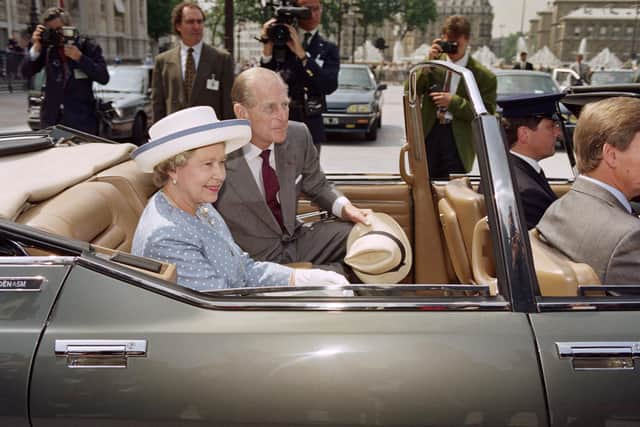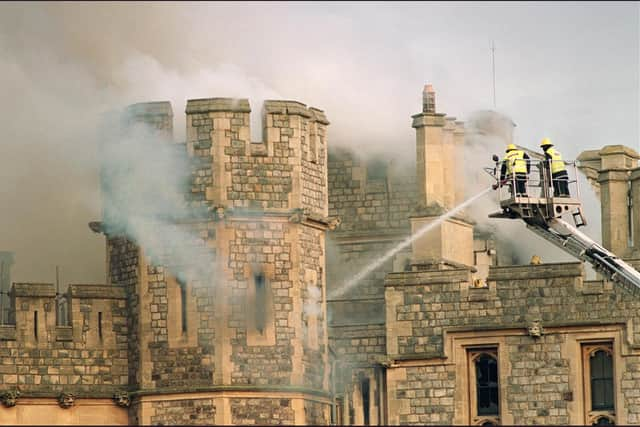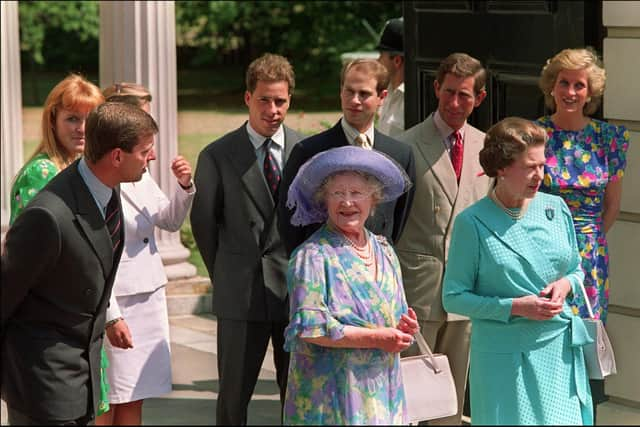Queen Elizabeth II’s reign: Fire at Windsor Castle and two Royal Splits marked the Queen’s ‘Annus Horribilis’
The horrible year in question was 1992, when the Prince and Princess of Wales were at war, the Duke and Duchess of York separated and Windsor Castle was ravaged by fire.
The Queen was not to know it, but others equally painful for her and damaging to the family lay ahead – Diana’s death in 1997, the Duke of York’s removal from public life in 2019 and the departure of Prince Harry and Meghan from royal duties in 2020.
Advertisement
Hide AdAdvertisement
Hide AdAs she grew older, the Queen faced crisis after crisis, the principal causes of which were the behaviour of her own children and grandchildren, whose devotion to duty and commitment to upholding the monarchy appeared a pale shadow of her own.


There were moments when the ties of affection between the monarchy and the British public came perilously close to being severed, when the future of the institution she headed was called into question, and when her own family seemed bent on self-destruction.
If she had visions of herself as the benign head of a happy and growing family that would be an example to the nation and Commonwealth, they were shattered.
Instead, from her 60s to her 90s she was faced with acrimonious marital problems, embarrassing scrutiny of her family’s behaviour and the erosion of public support for the monarchy.
Advertisement
Hide AdAdvertisement
Hide AdThe 1980s had started terrifyingly for her. On June 13 1981, during the Trooping the Colour ceremony, a teenage boy appeared from the crowd and fired six shots at the Queen as she rode by. Her horse reared, but she brought it back under control and carried on, displaying an iron self-discipline as troopers leaped upon the gunman.


Mercifully, the revolver was loaded with blanks, and it had been fired not by an assassin, but a deeply disturbed youth who craved attention.
A few weeks later, though, everything was happiness. The Queen could not have imagined what lay ahead as she surveyed the cheering crowds from the balcony of Buckingham Palace on July 29 1981, when Charles kissed his new bride in the most magical moment of a deliriously happy day.
Archbishop of Canterbury Robert Runcie had caught the public mood to perfection as he married Charles and Lady Diana Spencer at St Paul’s Cathedral, when he said the union was “the stuff of which fairy tales are made”.
Advertisement
Hide AdAdvertisement
Hide AdThe euphoria lasted into the following year, with the birth of Prince William on June 21. The succession to the throne was secure, and the Queen had a grandson she adored.


That same summer, she was at the centre of an unprecedented security scare. On July 7, she woke to find a dishevelled man called Michael Fagan sitting on the end of her bed in Buckingham Palace, drinking a bottle of wine from the cellar.
He wanted to have a chat, he explained, and the Queen, not knowing if he was dangerous, obliged. She twice pressed the emergency call button next to her bed, but no help came.
Eventually, Fagan asked for a cigarette, and staff finally responded to her call. The incident caused ructions. It was an astonishing and deeply worrying breach of security.
Advertisement
Hide AdAdvertisement
Hide AdThere was to be much more to worry her over the next three years, as the fabric of the Royal Family gradually unravelled.
By 1985, it was clear that the marriage of Charles and Diana was in serious trouble. Diana had suffered post-natal depression after William’s birth, developed the eating disorder bulimia and attempted suicide.
Charles had continued his relationship with long-term lover Camilla Parker-Bowles, and this condemned his marriage to failure, despite the birth of Prince Harry on September 16 1984.
There was a brief moment of respite for the family with the wedding of Prince Andrew to Sarah Ferguson on July 23 1986, but by decade’s end, it was clear that their marriage, too, was doomed.
Advertisement
Hide AdAdvertisement
Hide AdWorse was to come. As the 1990s dawned, commentators were writing about a Royal Family facing its greatest crisis since Edward VIII abdicated in 1936.
The starting point for widespread public resentment was a 50 per cent increase in the Civil List, which was seen as the public paying for Diana and the Duchess of York to enjoy jet-set lifestyles.
The Queen suffered the backlash of their profligacy. A clamour started over her wealth, and within two years, after negotiations with John Major’s government, it was announced that she would start paying income tax, to the tune of about £4m a year.
But by then, the apparently dysfunctional emotional lives of the younger Royals had seriously undermined the family’s standing in the country.
Advertisement
Hide AdAdvertisement
Hide AdThe Duchess of York was pictured on holiday having her toes sucked by her “business adviser”, Diana was taking a succession of lovers and it was an open secret about Charles and Camilla.
Confirmation that the public smiles and occasional shows of togetherness were a sham came during 1992, when the Duke and Duchess of York, Charles and Diana, and Princess Anne and her husband, Mark Phillips, all separated.
Then, in June, came the publication of Diana: Her True Story, by Yorkshire-born author Andrew Morton. It laid bare every ghastly secret - the suicide attempt, the eating disorders, the dawning realisation that Charles had never loved her, the lack of support she received.
It quickly became apparent that Diana had co-operated fully with Morton, and the mystique that had always been essential to the Royal Family was gone forever.
Advertisement
Hide AdAdvertisement
Hide AdIt seemed inconceivable that things could get any worse for the Queen. But then, on November 20, they did. Workmen at Windsor Castle accidentally started a fire that spread with alarming rapidity. Treasures were rushed to safety as the blaze raged through the building, destroying state rooms and the magnificent St George’s Hall.
The fire appeared to be an event of extraordinary symbolism for an embattled Royal Family.
The Queen looked bleak and haggard as she inspected the damage. This was not only one of the nation’s great monuments, it was also her home.
Misery piled upon her. The Government announced that the public purse would pay the £40m repair bill, and there was another outcry. Why couldn’t the richest woman in the land pay for it herself?
Advertisement
Hide AdAdvertisement
Hide AdOnce again, as she had over income tax, the Queen had to suffer the indignity of her private financial affairs becoming the stuff of public debate. To stave off further criticism and to try to cling on to what public affection there was left for the family, it was announced that £8-a-head tours of Buckingham Palace would be introduced to raise money towards the repair costs.
Four days after the fire, she faced her critics head-on in a speech at The Guildhall, with what amounted to a plea for an end to the savage criticism, and a pledge to reform the monarchy.
It was the most frank and personal speech she had ever made, and illustrated the Queen’s pragmatism.
Her voice was hoarse because of a heavy cold, but the emotional battering she had taken over the previous months may have played a part in her tone, too.
Advertisement
Hide AdAdvertisement
Hide AdShe said: “1992 is not a year on which I shall look back with undiluted pleasure.
“In the words of one of my more sympathetic correspondents, it has turned out to be an ‘Annus Horribilis’. I suspect that I am not alone in thinking it so.”
The Queen acknowledged that she should not be immune from criticism, but made it clear that the harshness of the attacks had hurt.
“There can be no doubt, of course, that criticism is good for people and institutions that are part of public life,” she said.
Advertisement
Hide AdAdvertisement
Hide Ad“No institution - City, monarchy, whatever - should expect to be free from the scrutiny of those who give it their loyalty and support, not to mention those who don’t.
“But we are all part of the same fabric of our national society and that scrutiny, by one part of another, can be just as effective if it is made with a touch of gentleness, good humour and understanding.”
Her plea worked. The most vicious of the criticism abated, and the beleaguered Royal Family won a breathing space.
Three years later, on November 20 1995, the Queen was faced with a crisis that went beyond her understanding because it was anathema to everything she believed about how royalty should behave.
Advertisement
Hide AdAdvertisement
Hide AdPrincess Diana gave a devastating interview to the BBC’s Panorama, in which she laid bare life inside the House of Windsor, and even speculated that Charles would never become King.
The Queen’s response was to do what she would once have considered unthinkable - to urge her heir to divorce the mother of the future King.
The divorce became final in 1996, and the Queen once again hoped that the worst was over.
Then, on August 31 1997, tragedy struck. Diana and her lover Dodi Fayed were killed in a car crash in Paris, and the Queen faced her greatest crisis yet, with public accusations of a lack of sympathy.
Advertisement
Hide AdAdvertisement
Hide AdIt took years for the Royal Family to fully rebuild its popularity, but by the time of the Diamond Jubilee in 2012, a younger generation - William and his wife Kate, and Harry – had done much to give it a new dynamism.
Yet in her mid-90s, as she approached her Platinum Jubilee, the Queen would once again face two family crises that forced her to put the welfare of the monarchy ahead of her love for a son and a grandson.